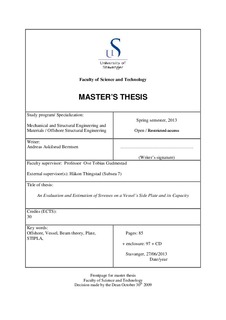| dc.contributor.author | Berntsen, Andreas Askilsrud | |
| dc.date.accessioned | 2013-09-30T11:28:36Z | |
| dc.date.available | 2013-09-30T11:28:36Z | |
| dc.date.issued | 2013 | |
| dc.identifier.uri | http://hdl.handle.net/11250/182734 | |
| dc.description | Master's thesis in Structural engineering | no_NO |
| dc.description.abstract | History shows that the combination of stresses and pressure in a vessel can cause
failure and lead to huge losses, examples of this are the ‘Prestige accident’ (November
2002) and the ‘Energy Concentration accident’ (July 1980). In the oil and gas industry
structures are often mobilized on the deck of a vessel, transported to a specific
location offshore and installed on the seabed. Occasionally these structures are quite
large, resulting in their sticking out from the deck. A side plate in the sheer strake area
needs to be evaluated, as stresses from the protruding structure, and stresses and
pressure from the vessel’s global loads, gives in-plane stresses and out-of-plane
pressure. In this study, the aim is to establish a simplified approach for estimating
stresses that arise from a vessels global loads, evaluate how much these stresses might
influence the plate capacity and conclude whether these stresses should be included in
a plate capacity check in Subsea 7.
At this time, researchers such as Paik, Owen and Mansour are considered as wellestablished
researchers in naval society, and their studies will be used to reach a
method for finding the arising stresses on plate that occur because of the global vessel
loads. The stresses will be estimated by idealizing the vessel as a hull girder and
applying beam theory combined with recommendations from Det Norske Veritas. The
study shows that there are several key factors to establish these stresses and these
factors will be estimated numerically and by computer software.
The study shows that a stiffened side plate that is subjected to in-plane and out-ofplane
stresses and pressure can experience failure modes when the structure on deck
results in large stresses. In this study a stiffened plate capacity checks will be
evaluated based on Det Norske Veritas (DNV) and NORSOK standards and
recommended practices, and are considered as state-of-the-art approaches.
The study concludes that both the magnitude of the global stresses and the stiffened
plate’s characteristics are key factors in determining how much the global stresses
influence the capacity of a specified plate. | no_NO |
| dc.language.iso | eng | no_NO |
| dc.publisher | University of Stavanger, Norway | no_NO |
| dc.relation.ispartofseries | Masteroppgave/UIS-TN-IKM/2013; | |
| dc.subject | mechanical | no_NO |
| dc.subject | structural | no_NO |
| dc.subject | offshore | no_NO |
| dc.subject | vessel | no_NO |
| dc.subject | beam theory | no_NO |
| dc.subject | plate | no_NO |
| dc.subject | STIPLA | no_NO |
| dc.subject | materialteknologi | no_NO |
| dc.subject | byggkonstruksjoner | no_NO |
| dc.title | An evaluation and estimation of stresses on a vessel's side plate and its capacity | no_NO |
| dc.type | Master thesis | no_NO |
| dc.subject.nsi | VDP::Technology: 500::Mechanical engineering: 570 | no_NO |
